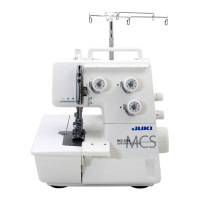Adjustments and settings
Differential feed
There are two feed dogs: one front (A) and one rear (B). The two
feed dogs move independently and the distance each feed dog
travels during one complete movement can be adjusted.
The differential feed prevents fluting or waving in knits or stretch
fabrics and movement between the layers of fabric. It also ensures
pucker-free seams in smooth fabrics such as nylon or closely wo-
ven fabrics.
Perfectly at seams in knits or stretch fabrics.
The distance travelled by the front feed dog should be bigger than
that of the rear feed dog. The front feed dog, therefore, feeds an
amount of fabric which the rear feed dog can take up behind the
needle without stretching the fabric (C).
Pucker-free seams in nylon or closely woven fabrics.
The distance travelled by the rear feed dog should be bigger than
that of the front feed dog. The front feed dog, therefore, holds the
fabric back so that the rear feed dog can take it up behind the nee-
dle without any puckering (D).
AB
2
1.5
N(1)
0.7
C
D
23

